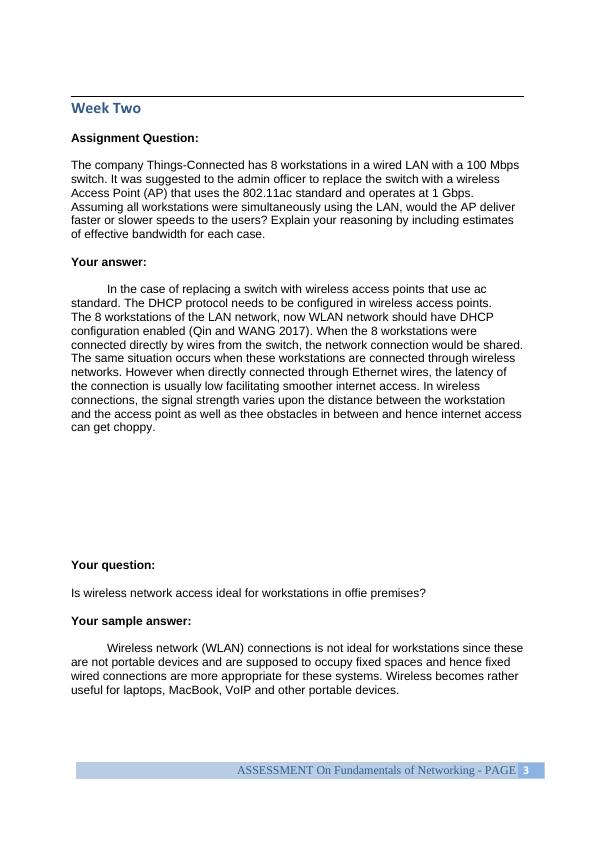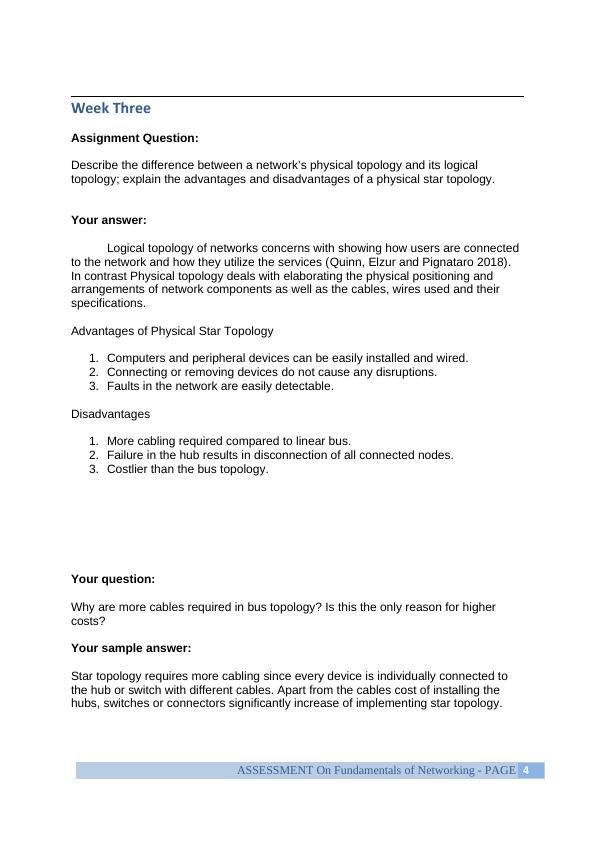Fundamentals of Networking Assignment
Added on 2023-01-19
14 Pages3329 Words65 Views
ASSIGNMENT SUBMISSION
Due date: Friday Week 11 (11:45 PM AEST)
Part: Written Assessment
Weighting: 30% of total assessment.
Submission: Electronic (see course website for details)
Instructions
While it should not be necessary to use literature/online resources to complete this
assignment, please ensure you cite and reference any such materials using the
Harvard format.
DO NOT copy content directly from either the text or Internet resources: this
assignment is to be in your own words. You will lose marks if you do not use
your own words!
Please complete your assignment using this submission template file, inserting your
responses where indicated.
DO NOT delete the marking criteria page – changes are permitted to the
formatting of other pages including the headers and footers.
Please fill in the following details:
Student Name
Student Number
ASSESSMENT On Fundamentals of Networking - PAGE 1
Due date: Friday Week 11 (11:45 PM AEST)
Part: Written Assessment
Weighting: 30% of total assessment.
Submission: Electronic (see course website for details)
Instructions
While it should not be necessary to use literature/online resources to complete this
assignment, please ensure you cite and reference any such materials using the
Harvard format.
DO NOT copy content directly from either the text or Internet resources: this
assignment is to be in your own words. You will lose marks if you do not use
your own words!
Please complete your assignment using this submission template file, inserting your
responses where indicated.
DO NOT delete the marking criteria page – changes are permitted to the
formatting of other pages including the headers and footers.
Please fill in the following details:
Student Name
Student Number
ASSESSMENT On Fundamentals of Networking - PAGE 1

Week One
Assignment Question:
It is common to be running several programs at once on your PC or laptop, for
example, listening to music while you are browsing webs. How is this possible?
Describe two ways that your PC or laptop can do, or appear to do, two or more things
at once.
Your answer:
Multiprogramming is the method of running multiple programs at any given
time. In multiprogramming systems, a number of programs get loaded into main
memory when batch processing is done (Lamichhane, Moreno and Fischmeister
2018). The first program starts to run and when it gets instructions to wait for
peripheral devices, the second program is given the chance to run. This process
follows for the n number of programs.
In multitasking, programs do not necessarily run for their entire duration unless
they are too short or poorly designed. The common resource shared by multiple
applications is shared among each other periodically. Thus it becomes possible to
browse the web and listen to music at the same time.
Your question:
How do programs accessing the same resource run concurrently in multitasking?
Your sample answer:
Every program is assigned a CPU time slice to ensure that all programs in the
queue get to run. A time slice is access to CPU for limited time. When this time slice
expires, the current program is suspended and the next program in the queue gets
CPU time.
ASSESSMENT On Fundamentals of Networking - PAGE 2
Assignment Question:
It is common to be running several programs at once on your PC or laptop, for
example, listening to music while you are browsing webs. How is this possible?
Describe two ways that your PC or laptop can do, or appear to do, two or more things
at once.
Your answer:
Multiprogramming is the method of running multiple programs at any given
time. In multiprogramming systems, a number of programs get loaded into main
memory when batch processing is done (Lamichhane, Moreno and Fischmeister
2018). The first program starts to run and when it gets instructions to wait for
peripheral devices, the second program is given the chance to run. This process
follows for the n number of programs.
In multitasking, programs do not necessarily run for their entire duration unless
they are too short or poorly designed. The common resource shared by multiple
applications is shared among each other periodically. Thus it becomes possible to
browse the web and listen to music at the same time.
Your question:
How do programs accessing the same resource run concurrently in multitasking?
Your sample answer:
Every program is assigned a CPU time slice to ensure that all programs in the
queue get to run. A time slice is access to CPU for limited time. When this time slice
expires, the current program is suspended and the next program in the queue gets
CPU time.
ASSESSMENT On Fundamentals of Networking - PAGE 2

Week Two
Assignment Question:
The company Things-Connected has 8 workstations in a wired LAN with a 100 Mbps
switch. It was suggested to the admin officer to replace the switch with a wireless
Access Point (AP) that uses the 802.11ac standard and operates at 1 Gbps.
Assuming all workstations were simultaneously using the LAN, would the AP deliver
faster or slower speeds to the users? Explain your reasoning by including estimates
of effective bandwidth for each case.
Your answer:
In the case of replacing a switch with wireless access points that use ac
standard. The DHCP protocol needs to be configured in wireless access points.
The 8 workstations of the LAN network, now WLAN network should have DHCP
configuration enabled (Qin and WANG 2017). When the 8 workstations were
connected directly by wires from the switch, the network connection would be shared.
The same situation occurs when these workstations are connected through wireless
networks. However when directly connected through Ethernet wires, the latency of
the connection is usually low facilitating smoother internet access. In wireless
connections, the signal strength varies upon the distance between the workstation
and the access point as well as thee obstacles in between and hence internet access
can get choppy.
Your question:
Is wireless network access ideal for workstations in offie premises?
Your sample answer:
Wireless network (WLAN) connections is not ideal for workstations since these
are not portable devices and are supposed to occupy fixed spaces and hence fixed
wired connections are more appropriate for these systems. Wireless becomes rather
useful for laptops, MacBook, VoIP and other portable devices.
ASSESSMENT On Fundamentals of Networking - PAGE 3
Assignment Question:
The company Things-Connected has 8 workstations in a wired LAN with a 100 Mbps
switch. It was suggested to the admin officer to replace the switch with a wireless
Access Point (AP) that uses the 802.11ac standard and operates at 1 Gbps.
Assuming all workstations were simultaneously using the LAN, would the AP deliver
faster or slower speeds to the users? Explain your reasoning by including estimates
of effective bandwidth for each case.
Your answer:
In the case of replacing a switch with wireless access points that use ac
standard. The DHCP protocol needs to be configured in wireless access points.
The 8 workstations of the LAN network, now WLAN network should have DHCP
configuration enabled (Qin and WANG 2017). When the 8 workstations were
connected directly by wires from the switch, the network connection would be shared.
The same situation occurs when these workstations are connected through wireless
networks. However when directly connected through Ethernet wires, the latency of
the connection is usually low facilitating smoother internet access. In wireless
connections, the signal strength varies upon the distance between the workstation
and the access point as well as thee obstacles in between and hence internet access
can get choppy.
Your question:
Is wireless network access ideal for workstations in offie premises?
Your sample answer:
Wireless network (WLAN) connections is not ideal for workstations since these
are not portable devices and are supposed to occupy fixed spaces and hence fixed
wired connections are more appropriate for these systems. Wireless becomes rather
useful for laptops, MacBook, VoIP and other portable devices.
ASSESSMENT On Fundamentals of Networking - PAGE 3

Week Three
Assignment Question:
Describe the difference between a network’s physical topology and its logical
topology; explain the advantages and disadvantages of a physical star topology.
Your answer:
Logical topology of networks concerns with showing how users are connected
to the network and how they utilize the services (Quinn, Elzur and Pignataro 2018).
In contrast Physical topology deals with elaborating the physical positioning and
arrangements of network components as well as the cables, wires used and their
specifications.
Advantages of Physical Star Topology
1. Computers and peripheral devices can be easily installed and wired.
2. Connecting or removing devices do not cause any disruptions.
3. Faults in the network are easily detectable.
Disadvantages
1. More cabling required compared to linear bus.
2. Failure in the hub results in disconnection of all connected nodes.
3. Costlier than the bus topology.
Your question:
Why are more cables required in bus topology? Is this the only reason for higher
costs?
Your sample answer:
Star topology requires more cabling since every device is individually connected to
the hub or switch with different cables. Apart from the cables cost of installing the
hubs, switches or connectors significantly increase of implementing star topology.
ASSESSMENT On Fundamentals of Networking - PAGE 4
Assignment Question:
Describe the difference between a network’s physical topology and its logical
topology; explain the advantages and disadvantages of a physical star topology.
Your answer:
Logical topology of networks concerns with showing how users are connected
to the network and how they utilize the services (Quinn, Elzur and Pignataro 2018).
In contrast Physical topology deals with elaborating the physical positioning and
arrangements of network components as well as the cables, wires used and their
specifications.
Advantages of Physical Star Topology
1. Computers and peripheral devices can be easily installed and wired.
2. Connecting or removing devices do not cause any disruptions.
3. Faults in the network are easily detectable.
Disadvantages
1. More cabling required compared to linear bus.
2. Failure in the hub results in disconnection of all connected nodes.
3. Costlier than the bus topology.
Your question:
Why are more cables required in bus topology? Is this the only reason for higher
costs?
Your sample answer:
Star topology requires more cabling since every device is individually connected to
the hub or switch with different cables. Apart from the cables cost of installing the
hubs, switches or connectors significantly increase of implementing star topology.
ASSESSMENT On Fundamentals of Networking - PAGE 4

End of preview
Want to access all the pages? Upload your documents or become a member.
Related Documents
SEO Suggestions for Desklib - Online Library for Study Materiallg...
|14
|2321
|254
COIT11238 Networked Infrastructure Foundationslg...
|14
|3589
|42
COIT11238 - Networked Infrastructure Foundationslg...
|15
|3502
|93
COSC2665 Networking - Assignmentlg...
|6
|1453
|52
COIT20246 Assignment ICT Services Managementlg...
|12
|3930
|269
Desklib - Online Library for Study Materiallg...
|12
|3703
|336
